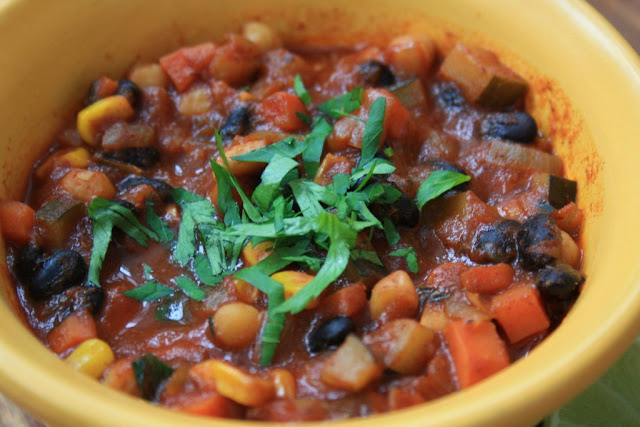Vegetarian Chili with beer is adaptable so feel free to add any kind of beans or vegetables. (Cubed sweet potato or squash are delicious additions.)
Just the thought of chili can warm me on a cold winter’s day. It’s a hearty meal and in many cookbooks you’ll find it listed as a vegetarian main dish rather than alongside the soups.
I have been making black bean chili for years but just last month came across a recipe that included a bottle of beer so I have modified my original recipe. While a full bottle is a little overpowering for me I find that half a bottle adds just the right amount of flavour to complement the spice.
Experiment with your favourite beer styles and read some great advice in the comments below.
Vegetarian Chili with Beer
Ingredients:
- 2 onions, diced
- 3 cloves of garlic, chopped
- 1 bay leaf
- 2 T chili powder
- 1 1/2 t cumin (or 4 t cumin seeds – much tastier)
- 4 t dried oregano
- 3 carrots, diced
- 1 medium zucchini, diced
- 1 cup frozen corn kernels
- 1 28 oz can or 24 oz bottle of tomatoes (prepared tomato sauce will do)
- 1 cup chickpeas or kidney beans
- 1 cup black beans
- ½ a bottle of beer
- 2 cups of water or broth
- 1 chipotle chili in adobo sauce (optional)
- 1-2 Tbsp. molasses
- ½ cup chopped cilantro
- Zest & juice of 1 lime
- Salt & pepper
Instructions:
- In a big pot over medium heat saute the onions until soft.
- Add the garlic, spices, oregano and bay leaf and stir for a minute then add the carrots and zucchini.
- Cover for 10 minutes, stirring a few times so the vegetables don’t scorch.
- Add corn, tomatoes, beans, beer, broth and chipotle (if using) and let simmer, uncovered for about 20 minutes.
- Season with salt & pepper, add the lime zest and juice and cilantro.
Serve with chunks of avocado and grated cheese.
Chili is adaptable so feel free to add any kind of beans or vegetables. Cubed sweet potato or squash makes for a delicious addition.







One thing I have found with beer in cooking – hoppy beers can add quite a lot of undesired bitterness, so don't use pale ales or IPAs or ESBs. I've had the best luck with brown ales (where you want something hearty) and wheat beer (where you want something lighter), both of which are lower in bitterness. Good choices would be Garrison's Barrack Street Brown, and any German or Belgian wheat beer – Blanche de Chambly is very nice. However even a lower hopped beer will add some bitterness – but sweetness can counteract this. Coincidentally, I added half a pint of homebrewed brown porter to my last batch of chili – and added 1 tsp of honey to balance out the bitterness.